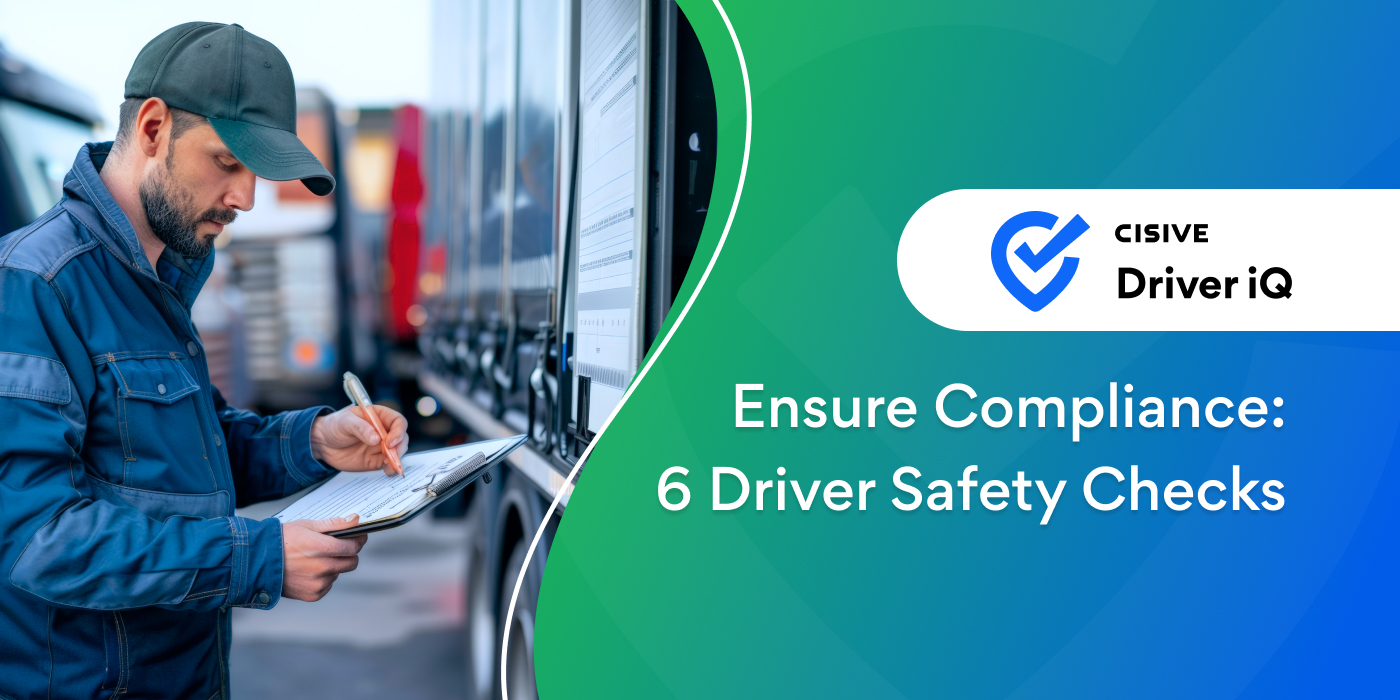

The Federal Motor Carrier Safety Administration (FMCSA) is a crucial agency within the U.S....

Keeping your fleet compliant and your drivers safe is a critical element of your fleet management. But with so many moving parts in transportation operations, it’s easy to overlook small safety details that carry big consequences. A single lapse in a routine safety check could lead to a failed inspection, a costly fine, or worse, an avoidable accident.
That’s where driver safety checks come in. These routine inspections and documentation reviews are the first line of defense against safety and compliance violations. Whether you're a fleet manager, HR leader, or compliance officer, knowing what to check and how often can make all the difference.
Key TakeawaysHere are the key things you need to know about driver safety checks:
|
Driver safety checks are routine inspections and administrative reviews that verify whether a commercial vehicle and its driver are ready to operate safely. These checks are mandatory under federal guidelines from the Federal Motor Carrier Safety Administration (FMCSA) and the Department of Transportation (DOT). For any fleet that operates across state lines or engages in interstate commerce, these checks are a daily and non-negotiable requirement.
A comprehensive safety check typically includes vehicle inspections (e.g., tire conditions, brake functionality, fluid levels) and driver-readiness assessments (e.g., possession of valid credentials, hours-of-service compliance, and health certifications). Each element is critical to ensuring that both the equipment and personnel meet legal and safety standards before every trip.
When performed consistently and correctly, these checks serve multiple purposes:
They identify mechanical issues early, reducing the chance of breakdowns or accidents.
They ensure that documentation is accurate and accessible in case of a roadside inspection.
They minimize liability exposure in the event of an incident.
They help avoid costly violations, such as out-of-service orders, citations, or disqualification from operating.
Moreover, safety checks play a key role in upholding your company’s reputation. A single compliance failure can lead to negative audit scores, DOT intervention, or lost business from risk-averse customers. By prioritizing safety checks, fleet operators protect lives and safeguard their bottom line.

Every commercial driver should conduct a pre-trip safety inspection before hitting the road. These checks are essential not just for compliance, but also for the safety of the driver and everyone else on the road.
Check engine oil, coolant, brake fluid, transmission fluid, and windshield washer fluid.
Conduct this Inspection every day before starting the vehicle.
Inspect tread depth and air pressure. Look for signs of wear or damage.
Check daily before each trip and weekly in greater detail.
Ensure that side and rear-view mirrors are clean, properly adjusted, and securely mounted.
Inspect at the beginning of each shift.
Test brake responsiveness, and inspect brake pads and air brake systems.
Conduct daily brake function tests and monthly mechanical inspections.
Check headlights, brake lights, turn signals, hazard lights, windshield wipers, and reflectors for functionality.
Perform a light check before every trip.
Ensure the driver carries a valid commercial driver’s license, medical examiner’s certificate, registration, insurance, and vehicle inspection reports.
Keep documents updated, reviewing weekly for accuracy.
Safety checks aren’t limited to the vehicle. A culture of safety starts with the people inside your organization.
Creating a culture of safety means investing in your workforce as much as your processes. A proactive approach to driver development, paired with rigorous background screening, can reduce incident rates, strengthen compliance, and boost employee retention.
Ongoing driver training reinforces safe driving practices and keeps drivers updated on the latest regulations. Programs like defensive-driving courses, fatigue-management workshops, and hands-on vehicle inspections give drivers the skills they need to operate safely and responsibly.
When safety training is embedded into your company’s culture and not treated as a one-time event, it becomes second nature for drivers to make safety-first decisions.
Before you hand over the keys, you need to know exactly who you’re hiring. Checking a driver’s history is critical to reducing risk to your fleet, your brand, and the public. Robust background checks can surface red flags that might not appear during interviews or on resumes. These include:
Employment verification to confirm driving history, tenure, and previous performance.
Motor vehicle records (MVRs) that highlight traffic violations, license status, and accident history.
Pre-employment screening program (PSP) reports that reveal any federal safety violations or crash data tied to a driver’s record.
Even more powerful is continuous driver monitoring, which enables you to track new violations, license suspensions, or medical certification expirations in real time. This real-time oversight allows HR and compliance teams to intervene before small issues escalate into DOT violations or disqualifications.
Failing to follow safety protocols can have devastating consequences. Beyond DOT fines and failed roadside inspections, noncompliance can result in vehicle out-of-service orders, civil litigation, and escalating insurance premiums. In worst-case scenarios, poor safety practices can lead to the revocation of your operating authority.
According to FMCSA data, in 2024 alone, the federal government issued more than 20,000 out-of-service violations to fleets, many of which were preventable violations such as brake defects, expired medical certificates, and missing inspection records. These violations can result in service delays, lost revenue, and damaged customer trust.
Furthermore, a single crash tied to safety negligence could trigger multimillion-dollar lawsuits, especially if the organization is found in court to have inadequately trained or vetted its drivers. In today’s litigation-heavy environment, your safety record is part of your brand. Customers, insurers, and regulators are paying close attention.
To stay ahead of these risks, fleet leaders must treat safety as a strategic priority. Use this DOT inspection checklist to identify and address common compliance gaps before they become violations.
Driver iQ was built specifically for the transportation sector to simplify these challenges and provide scalable, automated tools that reduce risk at every stage of the driver life cycle.
Driver iQ’s platform streamlines key compliance tasks, including:
Pre-employment background checks that verify driving history and qualifications with pinpoint accuracy.
Real-time MVR monitoring that alerts fleet managers to license suspensions, traffic violations, or lapses in medical certification.
Retention roster management that provides an up-to-date view of your driver pool and highlights gaps in credentials or compliance before audits occur.
Customizable compliance tracking dashboards to monitor fleet safety metrics and prepare for internal or DOT audits.
By centralizing these tools into one user-friendly platform, Driver iQ eliminates manual errors, enhances visibility, and allows HR, safety, and compliance leaders to make proactive, data-driven decisions. Whether you're hiring new drivers or managing a seasoned fleet, Driver iQ helps ensure your team is always road-ready and audit-proof.
Driver safety checks are a cornerstone of a compliant and efficient fleet operation. But managing inspections, documentation, and driver history can be complex. Driver iQ simplifies this process by delivering end-to-end solutions that help you hire, retain, and monitor safer drivers.
Ready to improve compliance and reduce risk? Contact a Cisive Driver iQ pro to learn how their tools can enhance your safety protocols and keep your fleet on the road safely.
Author: Greg Conklin
Bio: Transportation Screening Specialist at Cisive Driver iQ | Unmatched Screening Solutions for Smarter, Safer Hiring. Transportation is my area of focus. Father of two, former Jet Ski racer.
Let's Connect on LinkedIn
The Federal Motor Carrier Safety Administration (FMCSA) is a crucial agency within the U.S....

What is the FMCSA Drug & Alcohol Clearinghouse? We are now two years into the Federal Motor Carrier...

On January 6, 2023, employers no longer have to check for drug & alcohol violations with a driver’s...